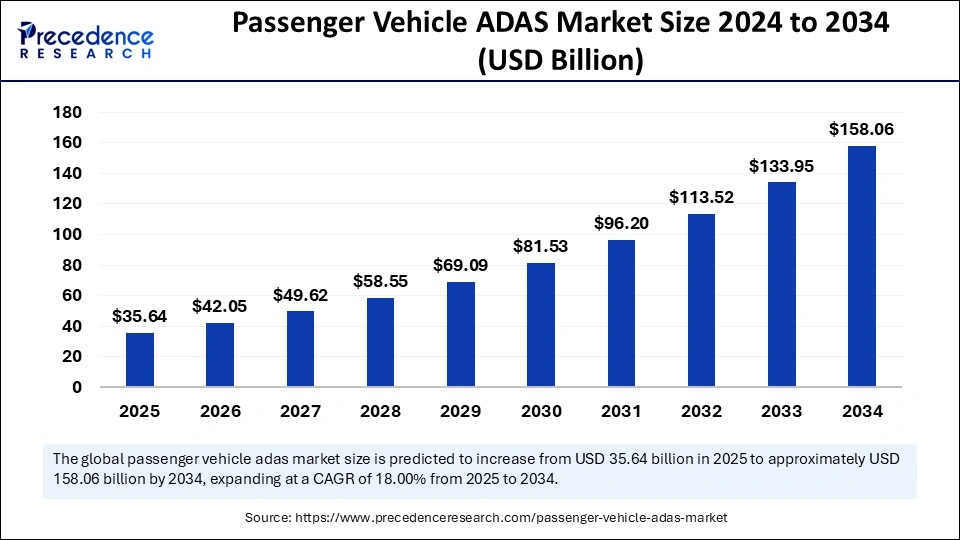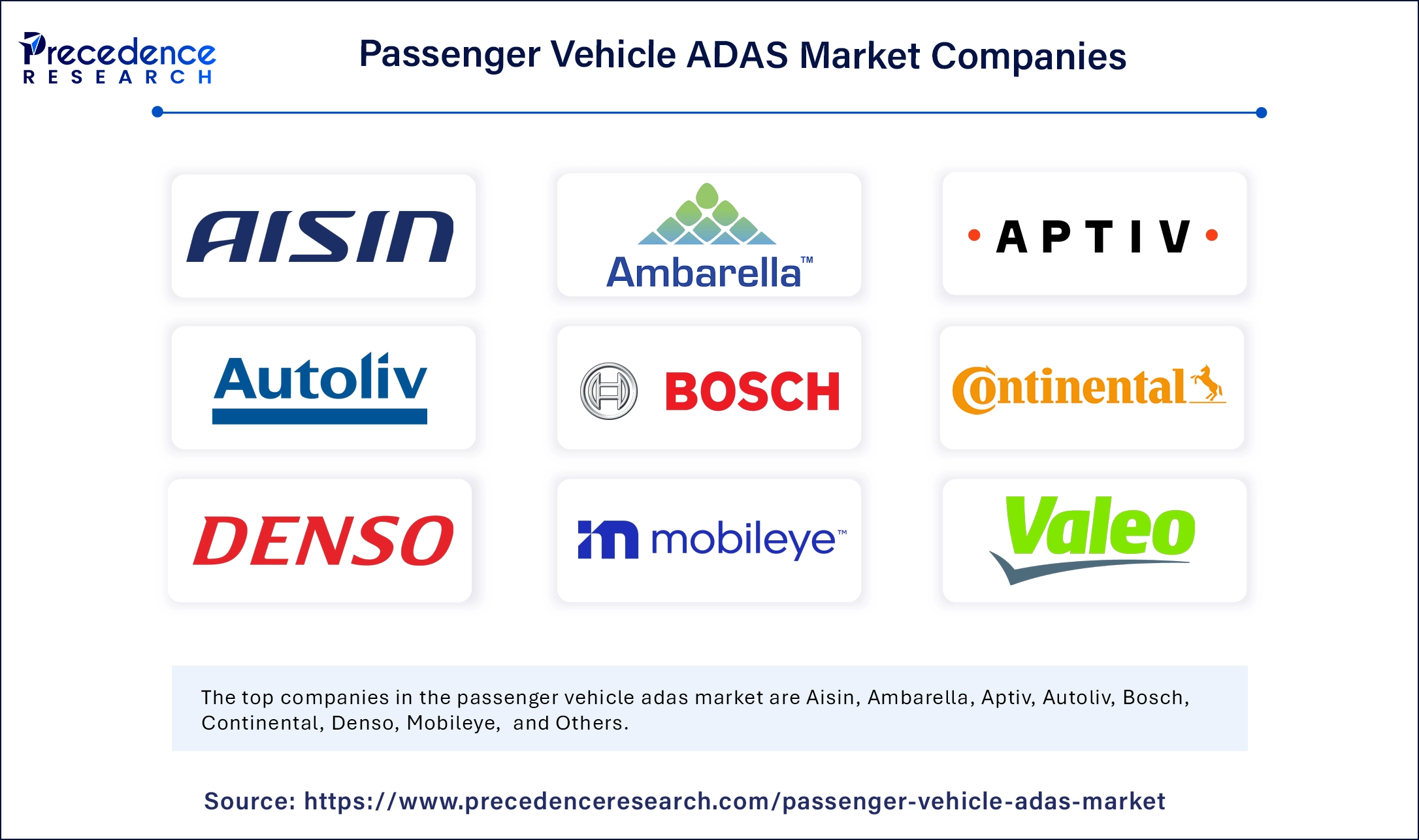The global passenger vehicle ADAS market size was estimated at USD 30.20 billion in 2024 and is expected to reach around USD 158.06 billion by 2034, growing at a CAGR of 18% from 2025 to 2034.

Passenger Vehicle ADAS Market Key Points
-
North America led the global market with the highest share of 36% in 2024.
-
The Asia Pacific market is estimated to expand at the fastest CAGR between 2025 and 2034.
-
Europe has been expanding at a significant pace in the global market.
-
By system, the lane departure warning system segment held the largest market share of 16% in 2024.
-
By system, the adaptive cruise control segment is anticipated to grow remarkably between 2025 and 2034.
-
By sensor, the radar segment captured the biggest market share in 2024.
-
By sensor, the LiDAR segment will expand at a notable CAGR over the projected period.
-
By vehicle, the SUV segment captured the biggest market share in 2024.
-
By vehicle, the hatchback segment is expected to grow at a notable CAGR over the projected period.
-
By distribution channel, the OEM segment captured the biggest market share in 2024.
-
By distribution channel, the after-market segment is expected to grow rapidly over the projected period.
Role of AI in Passenger Vehicle ADAS Market
Artificial Intelligence (AI) is a foundational technology driving the advancement of Advanced Driver Assistance Systems (ADAS) in passenger vehicles. AI enables real-time data processing from various sensors like cameras, LiDAR, radar, and ultrasonic systems to interpret the driving environment accurately. This allows ADAS features such as adaptive cruise control, lane-keeping assistance, automatic emergency braking, and traffic sign recognition to function with high precision and reliability.
AI also plays a critical role in enhancing driver behavior prediction and decision-making capabilities of ADAS. Machine learning algorithms continuously learn from driving patterns and environmental inputs to improve system performance over time. This adaptability not only boosts safety and comfort but also supports the development of semi-autonomous and autonomous driving systems, making AI indispensable to the future evolution of the passenger vehicle ADAS market.
Market Overview: Shaping the Future of Safer Driving
The Passenger Vehicle ADAS market has become a transformative force in the automotive industry, redefining how drivers interact with vehicles and improving overall road safety. ADAS refers to a suite of electronic technologies that assist drivers in driving and parking functions using a combination of sensors, cameras, radars, LiDAR, and AI-powered decision-making software. These systems include features like adaptive cruise control, lane departure warning, automatic emergency braking, blind-spot detection, and parking assistance. As consumer demand shifts toward safer, smarter, and more automated vehicles, ADAS has evolved from a luxury add-on to a crucial standard across many vehicle segments. The market is experiencing rapid adoption, driven by regulatory mandates, safety awareness, and the automotive industry’s roadmap toward fully autonomous driving.
Get the Sample Copy of the Report@ https://www.precedenceresearch.com/sample/6024
Passenger Vehicle ADAS Market Growth Factors
The growth trajectory of the passenger vehicle ADAS market is being propelled by a confluence of regulatory enforcement, automotive safety concerns, and ongoing innovations in sensor and AI technologies. Governments across Europe, North America, and parts of Asia are implementing stringent safety regulations and mandates that require the inclusion of basic ADAS features in new vehicles. These include the EU’s General Safety Regulation and the U.S. National Highway Traffic Safety Administration’s (NHTSA) safety roadmap, both of which push automakers toward incorporating technologies like automatic emergency braking (AEB) and lane-keeping systems. At the same time, advances in AI, sensor fusion, and vehicle-to-everything (V2X) communication are enabling more sophisticated and accurate ADAS functionalities. Automakers are also integrating over-the-air (OTA) update capabilities, allowing constant software upgrades that enhance system performance over time.
Market Scope
| Report Coverage | Details |
| Market Size by 2034 | USD 158.06 Billion |
| Market Size in 2025 | USD 35.64 Billion |
| Market Size in 2024 | USD 30.20 Billion |
| Market Growth Rate from 2025 to 2034 | CAGR of 18% |
| Dominated Region | North America |
| Fastest Growing Market | Asia Pacific |
| Base Year | 2024 |
| Forecast Period | 2025 to 2034 |
| Segments Covered | System, Sensors, Vehicle, Distribution Channel, and Regions |
| Regions Covered | North America, Europe, Asia-Pacific, Latin America and Middle East & Africa |
Passenger Vehicle ADAS Market Market Dynamics
Key Market Drivers: Rising Safety Awareness and OEM Integration
One of the primary market drivers is the increasing awareness among consumers about the benefits of vehicle safety systems. The growing frequency of road accidents due to human error has heightened public demand for enhanced in-vehicle safety features. As a result, many Original Equipment Manufacturers (OEMs) are making ADAS a standard inclusion, even in mid-range and entry-level passenger vehicles. The integration of ADAS also enhances vehicle value and brand perception, pushing OEMs to invest heavily in R&D and partnerships with tech companies. Additionally, the rising demand for semi-autonomous and autonomous driving capabilities is pushing Tier-1 suppliers and automakers to prioritize ADAS innovations. The penetration of electric vehicles (EVs) and smart mobility platforms further amplifies ADAS adoption, as these vehicles are often equipped with the latest driver-assistance technology by design.
Opportunities: AI Integration, Subscription Models, and Emerging Markets
The ADAS market for passenger vehicles offers multiple growth opportunities. Integration of AI and deep learning is opening doors to predictive and context-aware assistance systems, significantly enhancing driving safety and personalization. For instance, AI-powered driver monitoring systems (DMS) can detect fatigue or distraction and intervene to prevent accidents. The rising interest in Mobility-as-a-Service (MaaS) and autonomous taxis will also generate substantial demand for high-level ADAS suites. Another emerging opportunity lies in software-defined vehicles, where ADAS features are offered as upgradable or subscription-based services, creating recurring revenue streams for automakers and technology providers. Moreover, as vehicle ownership increases in emerging economies and governments invest in smart city infrastructure, there is a clear runway for ADAS proliferation in Latin America, Southeast Asia, and Africa, especially in urban areas where safety and traffic efficiency are paramount.
Challenges: Cost Barriers, Infrastructure Limitations, and System Complexity
Despite its promising future, the ADAS market faces several hurdles. One significant challenge is the high cost of advanced ADAS components, including sensors, processors, and camera systems, which makes it difficult for automakers to offer these features in budget vehicles without eroding margins. Additionally, in many regions, especially in developing economies, the supporting infrastructure for ADAS—such as road markings, signage, and 5G connectivity—is still underdeveloped, limiting functionality and safety. Another concern is the complexity of ADAS integration with legacy vehicle platforms and the need for seamless cooperation among hardware and software components. Moreover, false positives or negatives from ADAS systems can lead to driver mistrust, highlighting the importance of reliability and precision. The legal and liability issues related to automated decision-making in critical driving scenarios also present unresolved challenges for regulators and manufacturers alike.
Regional Outlook
Europe currently leads the global passenger vehicle ADAS market, driven by strong regulatory mandates from the European Union, an emphasis on road safety, and widespread adoption of high-end vehicles. Germany, France, and the UK are at the forefront, with automakers like BMW, Audi, and Mercedes-Benz integrating sophisticated ADAS across their lineups. North America, particularly the United States and Canada, also holds a significant market share due to a well-established automotive sector, increasing consumer preference for safety technologies, and government safety standards.
However, Asia-Pacific is emerging as the most dynamic region, projected to witness the fastest growth through 2034. China, Japan, South Korea, and India are rapidly scaling up ADAS deployment across vehicle segments. In China, the government’s intelligent vehicle roadmap and the aggressive rollout of 5G networks support ADAS integration. Japan and South Korea benefit from strong automotive R&D capabilities and a tech-savvy population. India is showing increasing potential as safety norms tighten and domestic manufacturers like Tata and Mahindra begin integrating basic ADAS into more affordable models. Latin America and the Middle East & Africa are still in early stages of adoption but are expected to grow gradually with improvements in automotive infrastructure and rising awareness about vehicle safety.
Passenger Vehicle ADAS Market Companies

- Aisin
- Ambarella
- Aptiv
- Autoliv
- Bosch
- Continental
- Denso
- Mobileye
- Valeo
Segments Covered in the Report
By System
- Adaptive cruise control
- Blind spot detection
- Lane departure warning system
- Automatic emergency braking (AEB)
- Forward collision warning
- Night vision system
- Driver monitoring
- Tire pressure monitoring system
- Head-up display
- Park assist system
- Others
By Sensor
- Radar
- Lidar
- Camera
- Others
By Vehicle
- Sedan
- SUV
- Hatchback
By Distribution Channel
- OEM
- Aftermarket
By Region
- North America
- Europe
- Asia Pacific
- Latin America
- Middle East and Africa
Read More: Noise Control System Market
Source: https://www.precedenceresearch.com/passenger-vehicle-adas-market